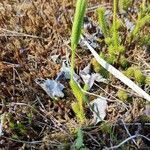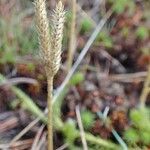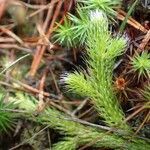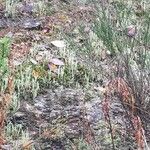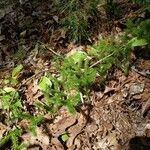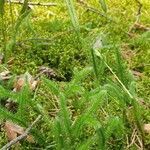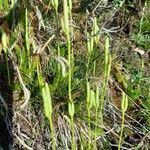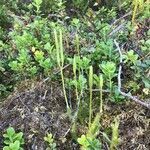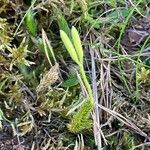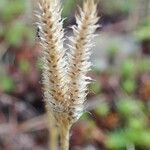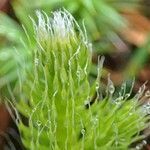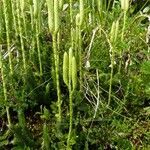Stolons subterranean, slender and creeping, 1 or 2 times forked, green, with sparse entire leaves; lateral branches erect, 20-25 cm tall, 3-5 times forked, sparse, flattened (young branches terete), stem together with leaves 9-12 mm in diam. Leaves spirally arranged, dense, angled upward, lanceolate, 4-6 × ca. 1 mm, leathery, with transparent hairs, midrib visible on both surfaces, base cuneate, decurrent, sessile, margin entire, apex acuminate. Strobili 2(or 3) together on a peduncle, peduncle up to 12 cm, bracts of peduncle spirally arranged, sparse, herbaceous, narrowly lanceolate; strobili erect, terete, 3.5-4.5 cm × ca. 4 mm, subsessile or with short, equally long pedicels; sporophyll broadly ovate, ca. 1.5 × 1.3 mm, papery, margin membranous, erose, apex acute, with short acute tip. Sporangia slightly exposed.
Horizontal stems superficial, elongate, arching and rooting at intervals, 2–3 mm thick, not dorsiventral, the lvs curved upwards; erect stems branched, to 2.5 dm; lvs mostly 10-ranked, uniform, linear-subulate, 4–7 × 0.5–0.8 mm, slightly or scarcely toothed, attenuate to a hyaline hair-like tip 2–3 mm; cones 1.5–11 cm, 3–7 mm thick, 1–6 on remotely bracteate peduncles 1.5–15 cm; sporophylls yellowish, broad-based, abruptly acuminate, with scarious erose margins; sporangia reniform, ca 1.5 mm wide; spores 28–36 microns in diameter, the sides convex, the commissural and outer faces angular-reticulate, the commissures not in furrows; 2n=68. Open dry woods and rocky places in acid soil; circumboreal, s. in e. U.S. to N.C., W.Va., Mich., and Io.
Horizontal stems on substrate surface. Upright shoots clustered, 0.6--1.2 cm diam., dominant main shoot with 3--6 branches mostly in lower 1/2. Lateral branchlets few and like upright shoots; annual bud constrictions abrupt, branchlets mostly spreading. Leaves spreading, often somewhat ascending in distal 1/3 of branches, medium green, linear, 4--6 X 0.4--0.8 mm; margins entire; apex with narrow hair tip 2.5--4 mm. Peduncles 3.5--12.5 cm, with remote pseudowhorls of appressed leaves, loosely branched into 2--5 alternate stalks, 0.5--0.8 cm. Strobili 2--5 on alternate stalks (if double, usually with stalks 5--8 mm), 15--25 X 3--6 mm. Sporophylls 1.5--2.5 mm, apex abruptly reduced to hair tip. 2 n = 68.
Terrestrial. Main stem creeping, up to 3 mm in diameter, producing dichotomously branched upright stems at 50-100 mm intervals. Leaves narrowly lanceolate, patent to suberect or imbricate, up to 5 x 0.5 mm, with a translucent hair point up to 3 mm long apically, margin usually entire but sometimes ciliate in leaves on main stem. Strobili pedunculate, 20-80 mm long in groups of 2-5 (rarely solitary) at apex of sparsely leafy peduncle up to 190 mm long. Sporophylls broadly ovate, acuminate, 2-3 x 1.5-2 mm, margin finely lacerate.
Stems widely creeping, irregularly branched, up to 2 mm in diam., lateral branches erect, up to 180 mm long, sparsely leafy. Lycophylls herbaceous, acicular, with a translucent hair point, entire, up to 7 x 1 mm. Strobili pedunculate, in groups of 2-5, up to 30 mm long. Sporophylls ephemeral, herbaceous, narrowly to broadly ovate, laciniate, up to 4.5 x 2 mm. Sporangium reniform, up to 1.3 mm in diam.
Terrestrial. Stems erect, branching from a prostrate, branched main stem, 80-300 mm long. Leaves erect from branches at right angles, with aristate tips bent forward, 3-5 mm long, up to 0.6 mm wide; sporophylls ephemeral, distinct from sterile leaves. Sporangia short-stalked, borne in sporophyll axils in a terminal strobilus.
Sporophylls different from foliage leaves, grouped into pedunculate strobili. Horizontal stem producing much-branched, erect stems at intervals. Leaves hair-pointed. Erect stems not laterally compressed.
Perennial with prostrate main stem and dichotomously branched, erect stems. Leaves with a translucent hair point. Strobili pedunculate, in groups of 2-5.
A herb. It grows 40 cm tall.
